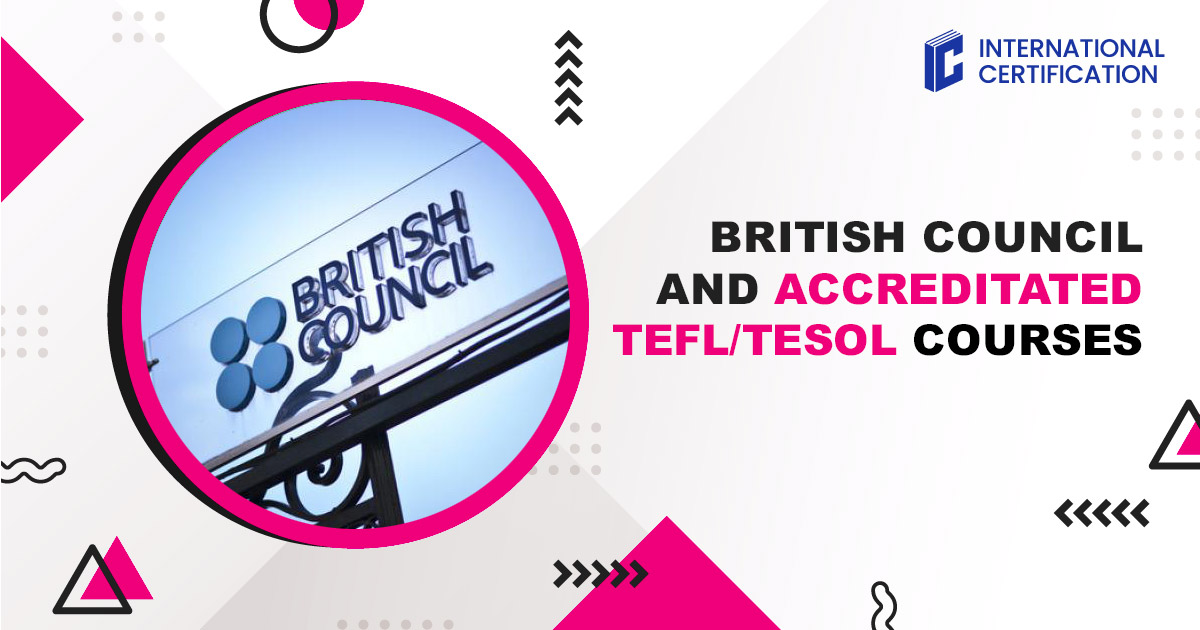And start earning money 💸 by teaching English in your own country, abroad, or online from anywhere on the planet! 🎁 Gifts and bonuses: professional support from your personal coach 🧑🏫 and job placement assistant 💼.

TED Talks. How to teach students to write and present an impactful speech
Public speaking can be a nightmare or the biggest fear for many. Your students might not be an exception. That's why it's every teacher's mission to help students overcome their fears and succeed as public speakers. TED talk practice is an excellent way to achieve this. Creating and presenting a TED talk can become a project that takes 4 to 5 60-minute lessons to complete. Therefore, prepare in advance a block of such lessons with clear steps and instructions.
The 1st Lesson
The 1st Step: Introduction to TED Talks
If your students are not familiar with TED Talks, this is a great opportunity for them to learn.
Objective: To familiarize students with TED Talks and their format.
Activity: Watch TED Talks from the official TED YouTube channel.
This can be a great listening activity. Choose interesting TED Talks to listen to in class, and prepare pre-listening and post-listening questions to engage students in discussion.
For example, if you choose the 'Are you a dreamer or a doer?' video to watch:
You may ask each student before listening if they consider themselves dreamers or doers, what the difference is, and whether they would like to change their roles in the future. Also, inquire if students have listened to TED Talks before, if they like them, and if they find them encouraging.
These are your pre-listening questions to engage students in a speaking activity.
Post-listening questions should be based on the content of the video. Therefore, watch it before the class and make a list of questions to check students' understanding of the TED Talk's content.
You can assign this as an individual writing task to complete – answering these questions, or, to encourage more speaking, make it a whole-class activity. However, ensure that every student participates. If you have a large class, divide them into groups and instruct each group to discuss the answers. Monitor the classroom during these discussions.
After completing this activity, move on and provide more TED Talk topic ideas, which you can find on the official YouTube channel.
Or here are 10 engaging and thought-provoking TED Talk topics that students can explore:
- The Power of Resilience: How overcoming personal challenges shapes our identity and strength.
- The Future of Education: Innovative ideas for transforming learning in the digital age.
- Climate Change and Youth Activism: The role of young people in driving environmental change.
- The Impact of Artificial Intelligence on Daily Life: Exploring how AI is reshaping the way we live, work, and interact.
- Mental Health in the Digital Era: Discussing the effects of technology and social media on mental well-being.
- Cultural Diversity and Global Understanding: Sharing personal stories to highlight the importance of cultural exchange and empathy in a globalized world.
- The Science of Happiness: Investigating what truly makes us happy and how we can apply this understanding in our daily lives.
- The Art of Storytelling: How storytelling influences human connection and can be used as a powerful tool for change.
- Space Exploration: Dreams and Realities: Discussing the latest developments in space travel and what it means for the future of humanity.
- Breaking Down Gender Stereotypes: Challenging traditional gender roles and promoting gender equality in various aspects of life.
These topics offer a range of ideas that students can tailor to their interests and experiences, encouraging them to explore and share their unique perspectives.
Then, ask the students for any ideas they might have about possible topics for their TED Talks.
The 2nd Step: Choosing a Topic
Objective: Help students select engaging and personal topics.
Activities:
Brainstorming session: Use mind maps to explore interests like technology, environment, or personal growth.
At this step, it's a great chance to show students how to create mind maps.
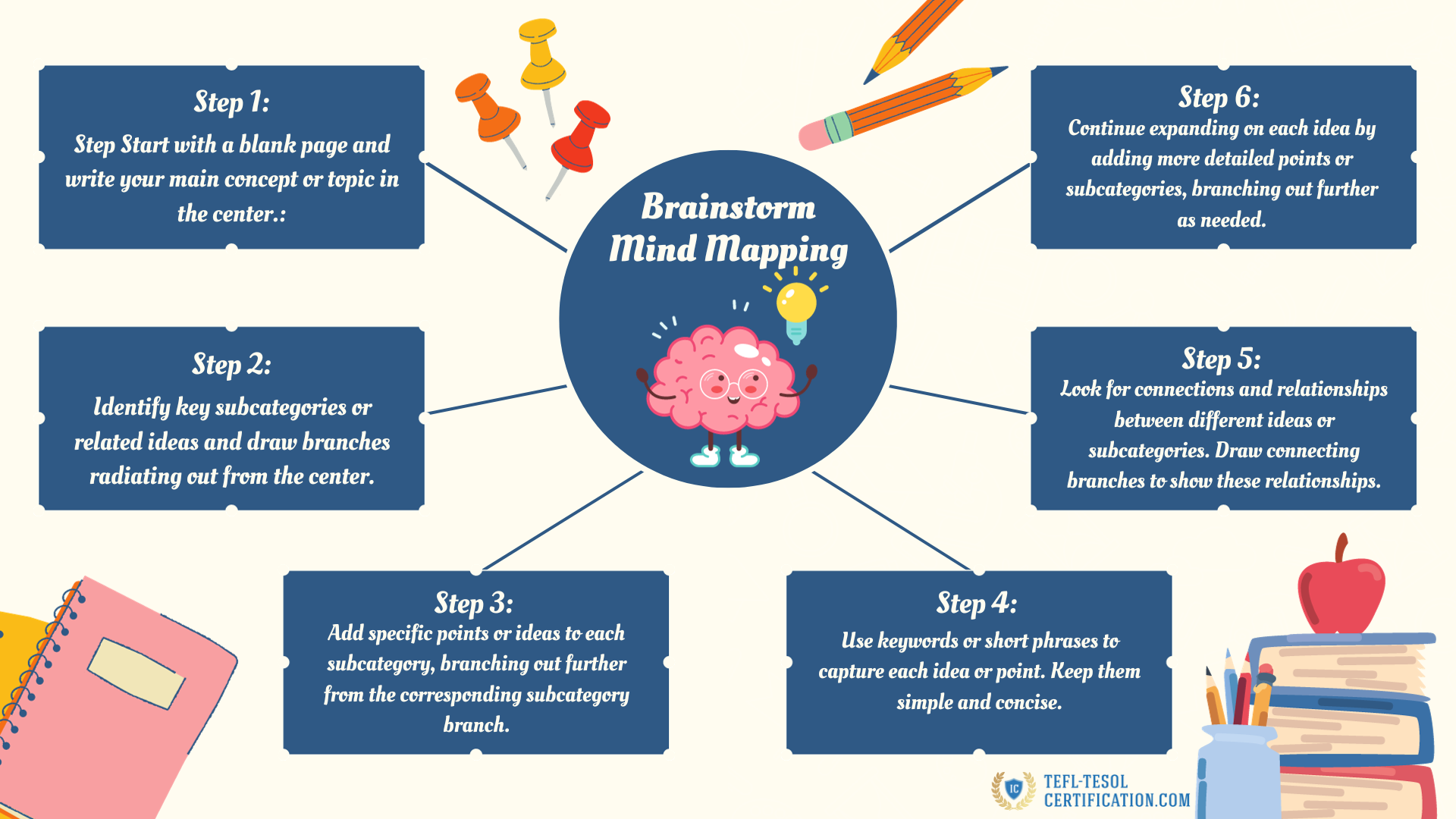
After explaining how mind maps are created, show the students an example. Use a mind map for the TED Talk titled 'The Art of Storytelling' as an illustration.
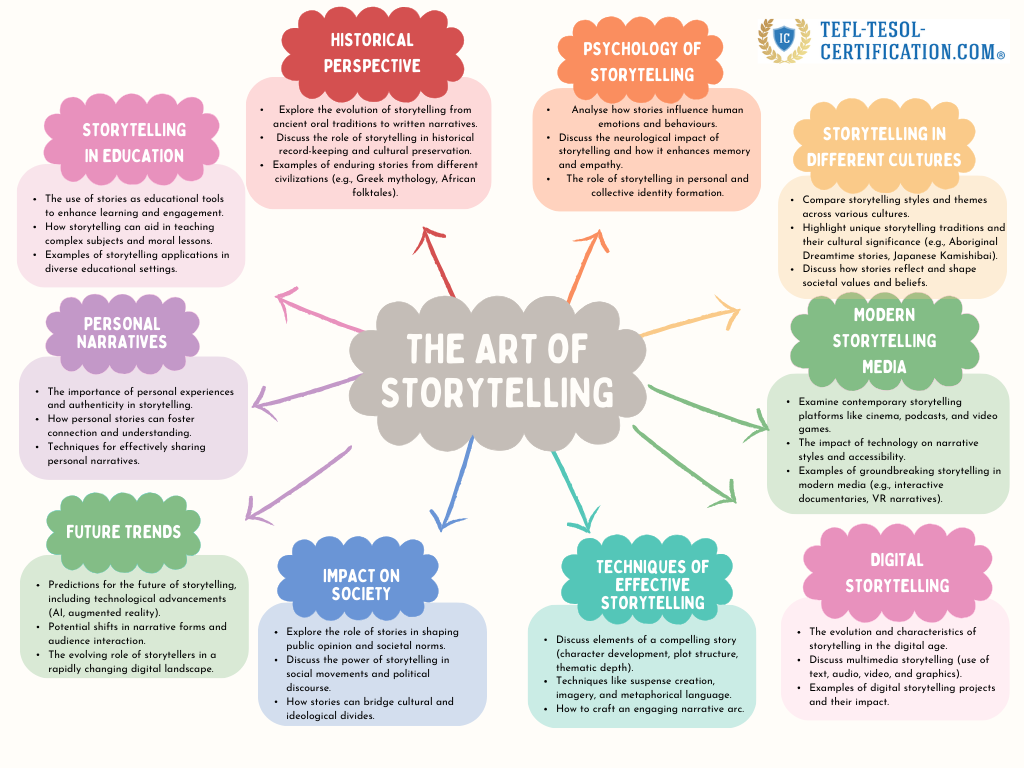
Here are brief notes for each of the subtopics on the mind map for the TED Talk 'The Art of Storytelling':
- Historical Perspective
- Explore the evolution of storytelling from ancient oral traditions to written narratives.
- Discuss the role of storytelling in historical record-keeping and cultural preservation.
- Examples of enduring stories from different civilizations (e.g., Greek mythology, African folktales).
- Psychology of Storytelling
- Analyze how stories influence human emotions and behaviors.
- Discuss the neurological impact of storytelling and how it enhances memory and empathy.
- The role of storytelling in personal and collective identity formation.
- Storytelling in Different Cultures
- Compare storytelling styles and themes across various cultures.
- Highlight unique storytelling traditions and their cultural significance (e.g., Aboriginal Dreamtime stories, Japanese Kamishibai).
- Discuss how stories reflect and shape societal values and beliefs.
- Modern Storytelling Media
- Examine contemporary storytelling platforms like cinema, podcasts, and video games.
- The impact of technology on narrative styles and accessibility.
- Examples of groundbreaking storytelling in modern media (e.g., interactive documentaries, VR narratives).
- Techniques of Effective Storytelling
- Discuss elements of a compelling story (character development, plot structure, thematic depth).
- Techniques like suspense creation, imagery, and metaphorical language.
- How to craft an engaging narrative arc.
- Impact on Society
- Explore the role of stories in shaping public opinion and societal norms.
- Discuss the power of storytelling in social movements and political discourse.
- How stories can bridge cultural and ideological divides.
- Personal Narratives
- The importance of personal experiences and authenticity in storytelling.
- How personal stories can foster connection and understanding.
- Techniques for effectively sharing personal narratives.
- Storytelling in Education
- The use of stories as educational tools to enhance learning and engagement.
- How storytelling can aid in teaching complex subjects and moral lessons.
- Examples of storytelling applications in diverse educational settings.
- Digital Storytelling
- The evolution and characteristics of storytelling in the digital age.
- Discuss multimedia storytelling (use of text, audio, video, and graphics).
- Examples of digital storytelling projects and their impact.
- Future Trends
- Predictions for the future of storytelling, including technological advancements (AI, augmented reality).
- Potential shifts in narrative forms and audience interaction.
- The evolving role of storytellers in a rapidly changing digital landscape.
These notes offer a concise overview of each subtopic, providing a foundation for a more detailed exploration in a TED Talk format.
Group discussions to refine ideas: Divide students into groups so they come up with some topic and subtopic ideas.
The 3rd Step
The 3rd Step could be assigned as a homework task: Research and Content Development.
Before the next lesson, each student should choose a topic for their future TED talk, conduct research, and create a mind map. Provide students with guidelines on effective online research, citing sources, and avoiding plagiarism.
The 2nd lesson
The 2nd lesson in this project-based series is focused on mastering writing skills. Your goal is to demonstrate techniques, support them with examples, and encourage students to draft their speeches. This lesson requires thorough preparation, as many students find writing to be a challenging skill to master.
The 4th Step: Writing the Speech
Objective: To teach students how to craft a compelling and impactful speech using a structured approach, incorporating personal stories, theme development, supporting facts or anecdotes, and a strong call to action.
- Introduction to Speech Structure
- Activity: Interactive discussion on the key elements of an effective speech: introduction (with a personal story), body (theme development and supporting evidence), and conclusion (call to action).
- Example: Analyze a short example of a powerful speech segment, highlighting these elements. Again, choose any online available TED talk.
- Developing the Introduction with a Personal Story
- Activity: Students brainstorm and jot down a personal story that connects to their chosen topic.
- Guidance: Provide tips on how to make personal stories relatable and engaging (e.g., focusing on emotions, descriptive language).
- Theme Development and Support
- Activity: Students outline the main theme of their speech and identify 2-3 key points they want to make.
- Exercise: Students find facts, statistics, or anecdotes that effectively support their points.
Homework
Draft the introduction and first part of the body of their speech, incorporating their personal story and initial supporting points.
The 3rd lesson
The 5th Step: Drafting and Peer Review
Drafting and peer review are crucial in speech writing. Drafting allows the writer to flesh out their ideas and structure their speech coherently. It's a process of refining thoughts and arguments, ensuring clarity and impact. Peer review, on the other hand, provides valuable feedback. It helps identify areas that need improvement, such as unclear points or weak arguments. The process encourages collaboration and opens the door to diverse perspectives, enhancing the overall quality and effectiveness of the speech. Together, drafting and peer review are indispensable for crafting a compelling and persuasive speech.
- Drafting the Remaining Parts of the Speech
- Activity: Students complete the draft of their speech, ensuring they have a clear conclusion with a call to action.
- Example: Show examples of effective conclusions from well-known speeches.
Some examples:
Melissa Butler's Speech: Butler uses a challenge close, urging her audience to take action. Her concluding lines include a call to "look at yourself in the mirror, see all of your greatness, accept it, and love it." This kind of conclusion is powerful because it encourages the audience to not only reflect but also act on what they've heard.
Winston Churchill's "We Shall Fight on the Beaches": Churchill's conclusion is memorable for its resolute and defiant tone. He emphasizes the determination of the British people to fight against tyranny, concluding with the famous lines, “We shall fight on the beaches, we shall fight on the landing grounds, we shall fight in the fields and in the streets, we shall fight in the hills; we shall never surrender.”
Martin Luther King Jr.'s "I Have a Dream" speech is renowned for its powerful and inspiring conclusion. In this speech, King expresses his dream of freedom and equality arising from a land of slavery and hatred. He famously concludes with the words:
"I have a dream that one day this nation will rise up and live out the true meaning of its creed: 'We hold these truths to be self-evident, that all men are created equal.'"
- Peer Review Session
- Activity: In pairs, students exchange their drafts and provide feedback focused on clarity, emotional impact, and overall coherence.
- Guidance: Provide a peer review checklist to help students give constructive feedback.
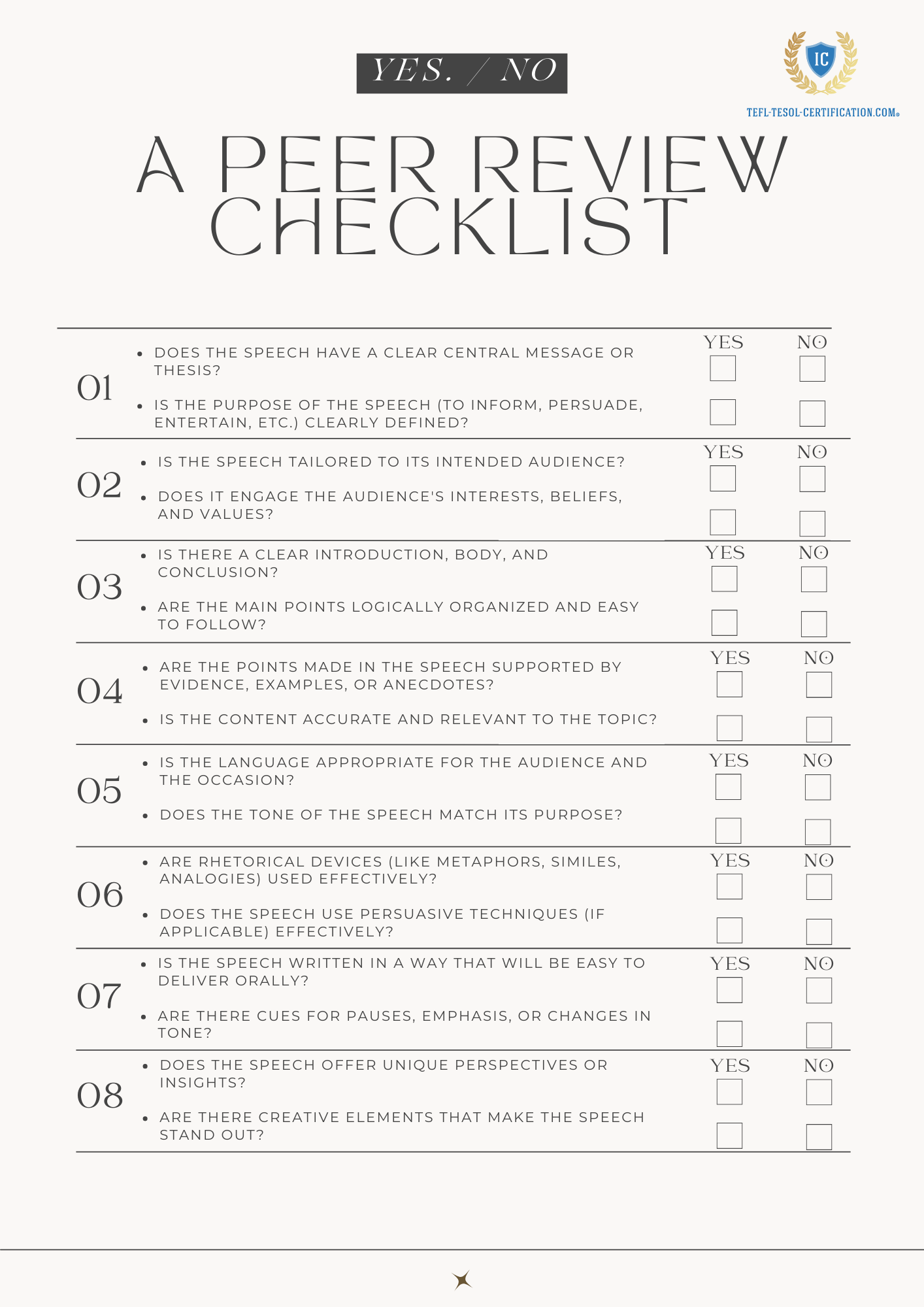
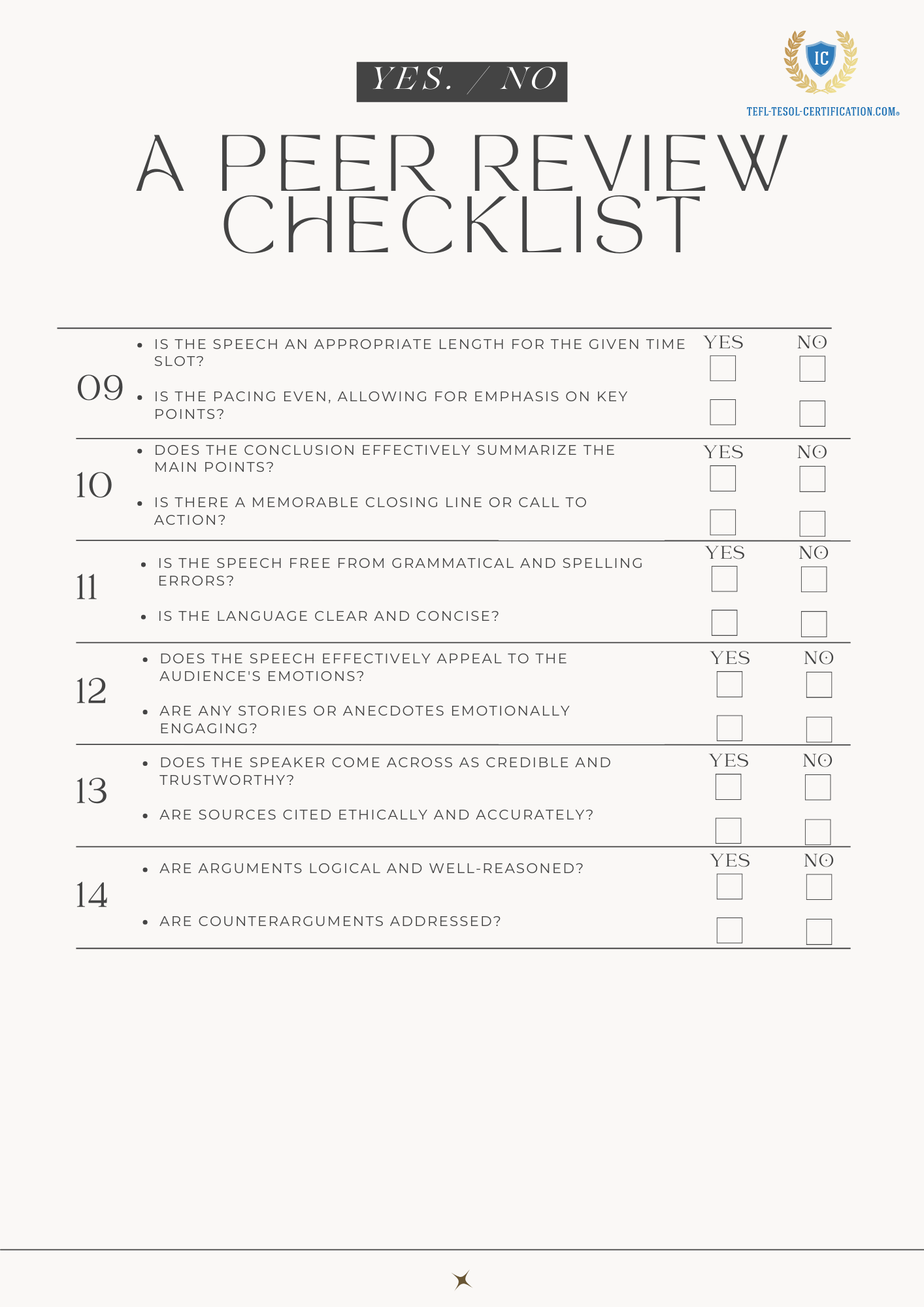
This checklist can be used as a guideline for peer reviewers to provide constructive feedback to the speaker, ensuring that the speech is effective and impactful.
Homework
Revise the speech based on peer feedback. Students make final revisions to their speeches based on peer feedback and their own reflections. Tell your students to use tools like Grammarly to edit for grammar, clarity, and style.
💡 Unlock the secrets to doubling your teaching income with our exclusive checklist! 🎯 This checklist is designed for English teachers who want to 📈 attract more students and 🔥 keep them engaged for the long term.
The 4th lesson
The 6th Step: Public Speaking Skills
Improving public speaking skills involves a combination of techniques that focus on delivery, content, and engagement with the audience. Here are some key techniques to enhance public speaking skills:
- Know Your Audience: Tailor your speech to the interests, level of understanding, and background of the listeners. This helps in making your speech more relevant and engaging.
- Organize Your Content: Have a clear structure for your speech – an introduction, body, and conclusion. This helps in conveying your message more effectively.
- Practice, Practice, Practice: Rehearsing your speech multiple times helps to reduce anxiety and improve your delivery. It also helps in memorizing your content and flowing more naturally.
- Work on Your Delivery: Pay attention to your tone, pace, and volume. Practice varying these to emphasize different parts of your speech.
- Use Body Language Effectively: Non-verbal cues, such as eye contact, gestures, and facial expressions, can greatly enhance your message and engage the audience.
- Engage the Audience: Ask questions, provide anecdotes, or use humor to relate to the audience. This interaction keeps the audience interested and attentive.
- Use Visual Aids Wisely: Visuals like slides or props can be effective, but they should support your speech, not detract from it. Ensure they are clear, simple, and relevant.
- Manage Public Speaking Anxiety: Techniques like deep breathing, visualization, or positive self-talk can help manage nervousness.
- Open Strongly and Close Powerfully: The beginning and end of your speech are crucial. Start with something that grabs attention, and finish with a strong, memorable point or call to action.
- Seek Feedback and Reflect: After your speech, reflect on what went well and what could be improved. Seek feedback from others to gain different perspectives.
- Keep It Simple and Clear: Avoid jargon and overly complex language. Clarity and simplicity make your message more accessible.
- Pause for Effect: Pauses can be powerful for emphasis and to give the audience time to absorb information.
- Continuously Learn and Adapt: Watch skilled speakers and learn from them. Be open to trying new techniques and continuously refining your skills.
- Personalize Your Speech: Share personal stories or experiences that relate to the topic. This makes your speech more engaging and relatable.
Effective public speaking is a skill that can be developed with practice and perseverance. Regularly applying these techniques can significantly enhance your students’ ability to communicate and engage with an audience effectively.
Objective of the 4th lesson is to improve students' public speaking abilities.
- Activities:
- Impromptu speaking on random topics for 2 minutes.
- Watch and critique famous speeches, focusing on delivery styles.
The 7th Step: Presentation Techniques
- Objective: Enhance students' presentation skills.
- Tips:
- Minimalistic slides with impactful images.
- Techniques for audience engagement like rhetorical questions.
- Activities:
- Workshop on effective use of PowerPoint or Prezi.
- Rehearsals with peer feedback focusing on slide transitions and timing.
The 5th lesson
🚀 More students, 💰 higher income, 🌍 complete freedom! ✅ 112 verified platforms with top rates ⏳ Flexible schedule – work whenever and as much as you want 🎯 Simple requirements – start earning right away 💎 Boost your career and income by teaching students worldwide!
The 8th Step: Final Presentation
- Objective: Showcase students' TED Talk speeches.
- Activity: Organize a class event. Invite other classes or parents to increase the authenticity of the experience.
Conclusion
Project-based learning and public speaking are crucial components in modern education, significantly enhancing students' learning experiences. Here are the key points emphasizing their importance:
- Hands-On Experience: Project-based lessons provide practical, hands-on experience that enhances understanding. Students apply what they've learned in a real-world context, fostering deeper learning and retention.
- Develops Critical Skills: These projects develop essential life skills such as problem-solving, critical thinking, collaboration, and time management. These skills are crucial for success in both academic and professional settings.
- Encourages Engagement and Motivation: Project-based learning often involves topics that interest students, thereby increasing engagement and motivation. It gives students a sense of ownership over their learning, leading to more enthusiastic participation.
- Public Speaking Skills: Incorporating public speaking into project-based lessons helps students develop confidence and communication skills. The ability to effectively articulate thoughts and ideas is vital in all areas of life.
- Opportunities for Public Speaking: Giving students opportunities to speak publicly, whether in class presentations or community events, prepares them for future academic and career challenges. It helps in overcoming fear of public speaking and enhances their ability to influence and inform others.
- Feedback and Reflection: These opportunities allow students to receive feedback, reflect on their performance, and identify areas for improvement. This iterative process is key to growth and skill development.
- Preparation for the Future: In a world where communication is key, the ability to speak publicly is invaluable. Project-based learning combined with public speaking prepares students for future challenges, be it in higher education or their professional careers.
Get your TEFL TESOL certification
Travel, work online, get a job abroad, or be
an EFL and ESL teacher in your country.
Incorporating project-based learning and public speaking into education not only enriches the curriculum but also equips students with vital skills necessary for their future success.
Terms used:
EFL, ESL

York Fern
An English instructor with 12+ years of experience. I work for an online school and travel the world, teaching students from various countries, leveraging my TEFL/TESOL certification. Seeing the world's oceans, mountains, and cities with my own eyes has given me a profound appreciation for the importance of quality education and international communication.
and start earning by teaching English in your country, abroad, or online from anywhere in the world! Order the course with a 50% discount 💸 and receive as a gift the support of a personal coach 👨🏫 and job placement assistant! 🎁🚀 Hurry, limited spots available! 🏃♂️💨
💡 Unlock the secrets to doubling your teaching income with our exclusive checklist! 🎯 This checklist is designed for English teachers who want to 📈 attract more students and 🔥 keep them engaged for the long term.
🚀 More students, 💰 higher income, 🌍 complete freedom! ✅ 112 verified platforms with top rates ⏳ Flexible schedule – work whenever and as much as you want 🎯 Simple requirements – start earning right away 💎 Boost your career and income by teaching students worldwide!
choose us?

